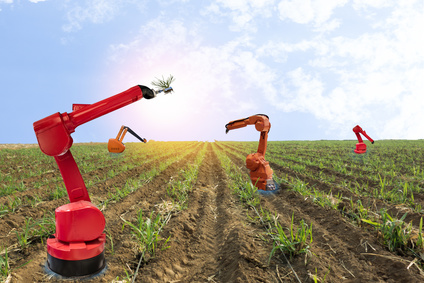The future of agritech: automated farms
A I • Nov 30,2017


The agriculture in near future will be fully automated. Every phase of operation, from seed to harvest, won’t require a participation of a human being. You may already have heard about artificial intelligence robots that are zapping weeds with accurate precision, autonomous tractors harvesting on a farmland and satellites accessing and checking crop health from outer space and feeding agritech startups with data.
Precision agriculture is a new phase of agriculture development, where smart machines can operate by themselves, which will increase the efficiency of producing agriculture. According to the professor, head of engineering at Harper Adams University and head of the National Centre for Precision Farming in the UK Simon Blackmore, ‘precision agriculture is becoming robotic agriculture’.
The project Hands Free Hectare and led by researchers from Harper Adams and private industry, farmed one hectare of spring barley without any human operation. Researchers and experts used updated Japanese tractor and drones as scouts to survey the operation and collect samples to help the team monitor the progress of the barley. At the end of experiment, robotic farmer harvested about 4.5 tons of barley.
“This project aimed to prove that there’s no technological reason why a field can’t be farmed without humans working the land directly now, and we’ve done that,” said Martin Abell, mechatronics researcher for Precision Decisions, which partnered with Harper Adams, in a press release. Basically, it proved a theory that there’s no technological reason why a field can be farmed without humans working the land directly.
Another example of machines, that are disrupting the agricultural industry, is a startup called Blue River Technology. Deere & Company announced it will buy a ‘see-and-spray’ system combined with computer vision and artificial intelligence for $305 million. It hits the former with fertilizer and blasts the latter with herbicides with such precision that it can eliminate 90 percent of the chemicals used in conventional agriculture.
Abundant Robotics is developing robots capable of picking apples with vacuum-like arms that suck the fruit straight off the trees in the orchards. The robots, that will be used in food and agricultural applications will be different from traditional robots, designed for very specific tasks. This means future agritech robots have to able to complete multiple tasks, needed in farming.
The future farm will rely on drones, satellites and other tools that will provide data that will help to grow a successful crop. Descartes Labs is building a data refinery for satellite imaginary. Machine learning allows to analyse data and forecast soy and corn yields. It collects terabytes of images, including NASA and the European Space Agency. With a help of weather readings and other real-time inputs, cornfield yields can be predicted with 99 percent accuracy.
The startup got a $1.5 million funding from the DARPA to monitor and analyze wheat yields in the Middle East and Africa. The idea behind this task is to make accurate forecasts in regions with high risk of crop failure. Another company called TellusLabs out of Somerville, Massachusetts also employs machine learning algorithms to predict corn and soy yields with similar accuracy from satellite imagery.
Another great example is Ceres Imaging, a startup that produces high-resolution images from multispectral cameras flown across fields aboard small planes. These images are used by farmers to identify a problem with water stress or level of chlorophyll.
Climate change is the main problem that needs to be solved by the help of artificial intelligence, future algorithms and machines. That’s why more and more companies and experts are interested in so-called controlled environment agriculture. It’s everything from automated vertical farms to agriculture warehouses controlled by robots. High-technology indoor farms can produce much higher yields and save more water, herbicides and human work.
Iron Ox is developing urban greenhouses that will be operated by artificial intelligence robots and reportedly capable of producing the equivalent of 30 acres of farmland. The robots will be responsible for the entire operation, including planting, nurturing and harvesting the crops. A vertical farming startup called Plenty uses AI to automate its conventional agriculture system.
Indoor farming can be used in an economically disadvantaged food desert, in order to stimulate a broader economic impact that could create jobs and generate income for that area. This model of agriculture is more adaptable to becoming an engine for economic growth and food security. At the same time, the model is criticised for the potential premium prices for food and increased use of electricity.
Food and Agriculture Organization of the United Nations predicts that the world must boost food production by 70 percent to meet the needs of the population. Artificial intelligence, robotic farmers and automated greenhouses will help to feed it.
Author: AI.Business
If you like our articles, please subscribe to our monthly newsletter:
[mc4wp_form id=”763″]